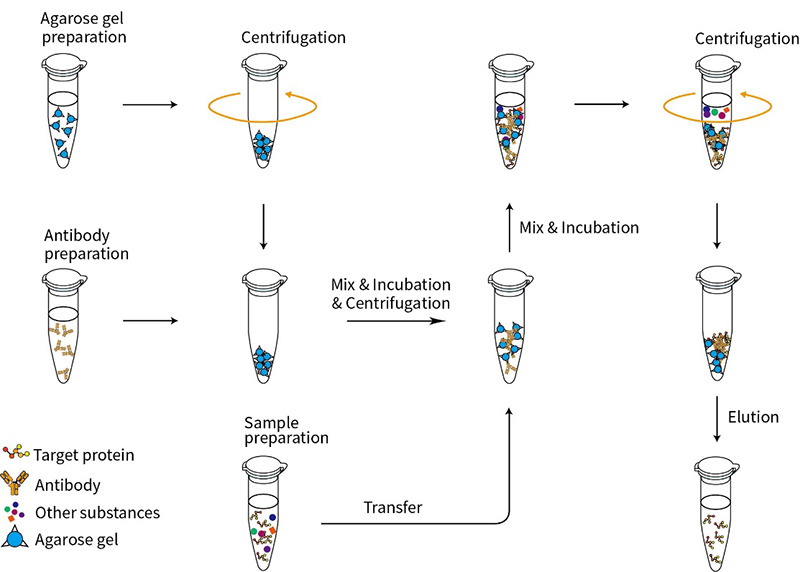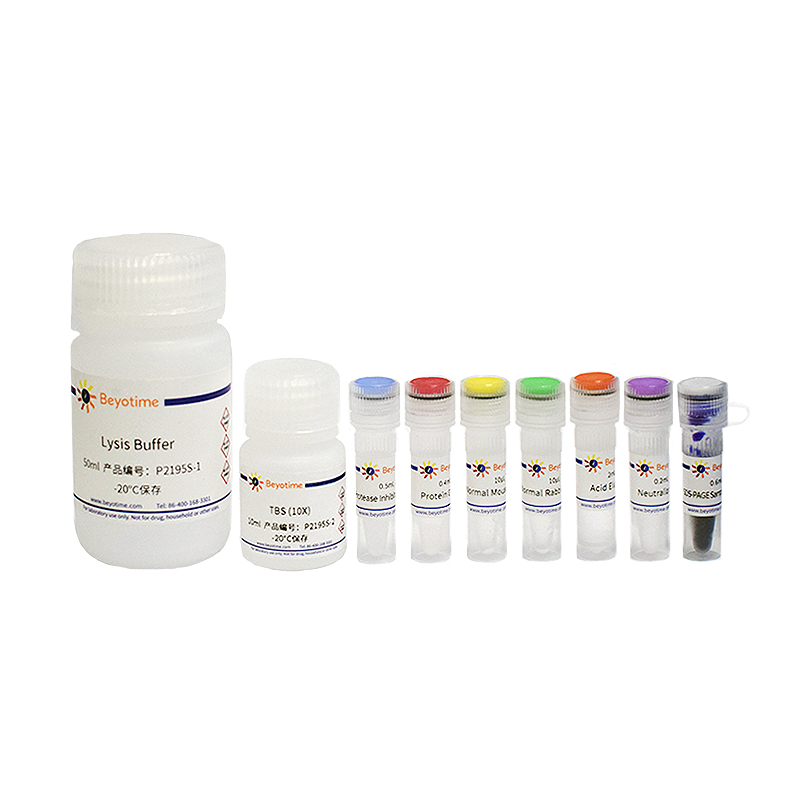


 微信在线咨询
微信在线咨询


| 产品编号 | 产品名称 | 产品包装 | 产品价格 |
| P2195S | 免疫沉淀试剂盒(Protein G琼脂糖凝胶法) | 20次 | 699.00元 |
| P2195M | 免疫沉淀试剂盒(Protein G琼脂糖凝胶法) | 100次 | 2289.00元 |
碧云天生产的免疫沉淀试剂盒(Protein G琼脂糖凝胶法) (Immunoprecipitation Kit with Protein G Agarose Gel)是一种通过高质量的重组Protein G琼脂糖凝胶,配合用户自备的特异性抗体,进行目的蛋白免疫沉淀或免疫共沉淀的试剂盒。本产品的免疫沉淀产物,可以用于目的蛋白或其蛋白复合物组分的检测。
本试剂盒包含高质量的Protein G琼脂糖凝胶及经过优化验证的免疫沉淀必要试剂,使免疫沉淀(Immunoprecipitation, IP,也称Pull-down)或免疫共沉淀(Co-IP)实验更加简单、便捷、高效,配合特异性抗体,广泛用于目的蛋白或其蛋白复合物的免疫沉淀、免疫共沉淀或纯化等实验。
免疫沉淀或免疫共沉淀是研究蛋白或蛋白与蛋白相互作用(Protein-Protein Interactions, PPIs)的常用实验技术,通过使用特异性抗体和可结合抗体的介质(如Protein A/G Agarose或Protein A/G磁珠),或直接使用偶联特异性抗体的介质(如琼脂糖凝胶或磁珠),然后通过离心或磁力从溶液中分离出抗原和抗体复合物,从而将目标蛋白质从复杂样品中分离出来,随后可以用于Western印迹检测或质谱分析等[1-2]。
Protein G是C型或G型链球菌(Streptococcal bacteria)表达的免疫球蛋白结合蛋白;Protein A是一种发现于金黄色葡萄球菌(Staphylococcus aureus)的细胞壁表面蛋白,分子量为42kDa。Protein G和Protein A功能相似,能特异性地与哺乳动物免疫球蛋白(Immunoglobulin, Ig)结合,结合的部位通常为免疫球蛋白的Fc区,但有资料显示Protein A也会和人VH3家族的Fab区结合,而Protein G有时与Fab区也有一定结合。同时,两者对于不同的免疫球蛋白亚类的结合能力有所不同。适当重组改造的Protein A、G与琼脂糖凝胶以一定的方式结合,可用于免疫沉淀或抗体的纯化[3-4]。
Protein G琼脂糖凝胶适合于免疫沉淀human IgG1、IgG2、IgG3、IgG4,mouse IgG1、IgG2a、IgG2b、IgG3,rat IgG1、IgG2a、IgG2b、 IgG2c,以及rabbit、goat多克隆抗体;而Protein A琼脂糖凝胶适合于免疫沉淀human IgG1、IgG2、IgG4,mouse IgG2a、IgG2b及rabbit IgG等。下表是碧云天Protein A、Protein G、Protein A/G琼脂糖凝胶产品与人、小鼠、大鼠常见的免疫球蛋白亚类的结合能力及不同物种的总结合能力情况表。
| Species | Ig | Protein A | Protein G | A+G |
| Human | IgG1 | ++++ | ++++ | ++++ |
| IgG2 | ++++ | ++++ | ++++ | |
| IgG3 | - | ++++ | ++++ | |
| IgG4 | ++++ | ++++ | ++++ | |
| IgA | ++ | - | ++ | |
| IgD | ++ | - | ++ | |
| IgE | ++ | - | ++ | |
| IgM | ++ | - | ++ | |
| Mouse | IgG1 | + | ++++ | ++++ |
| IgG2a | ++++ | ++++ | ++++ | |
| IgG2b | +++ | +++ | +++ | |
| IgG3 | ++ | +++ | +++ | |
| IgM | +/- | - | +/- | |
| Rat | IgG1 | - | + | + |
| IgG2a | - | ++++ | ++++ | |
| IgG2b | - | ++ | ++ | |
| IgG2c | + | ++ | ++ | |
| IgM | +/- | - | +/- |
| Total Ig | Protein A | Protein G | A+G |
| Human | ++++ | ++++ | ++++ |
| Mouse | +++ | +++ | +++ |
| Rat | +/- | ++ | ++ |
| Rabbit | ++++ | +++ | ++++ |
| Goat | - | ++ | ++ |
| Chicken | - | + | + |
| Cow | ++ | ++++ | ++++ |
| Guinea Pig | ++++ | ++ | ++++ |
| Hamster | + | ++ | ++ |
| Horse | ++ | ++++ | ++++ |
| Pig | +++ | +++ | +++ |
| Sheep | +/- | ++ | ++ |
本产品中的重组Protein G可与多数哺乳动物IgG的Fc端特异性结合,分子量为22kDa。该重组Protein G通过改造,仅保留了与IgG Fc端结合相关的氨基酸序列,去除了结合位点以外可能导致非特异性结合的序列,从而可以有效减少非特异性结合。本产品的每个Protein G分子可以结合3个IgG分子。
本试剂盒包含高质量的Protein G琼脂糖凝胶、Normal Mouse IgG和Normal Rabbit (正常小鼠IgG和兔IgG,作为阴性对照)及优化的各种缓冲液如Lysis Buffer、TBS (10X)、Protease Inhibitor Cocktail (100X)、Acid Elution Buffer、Neutralization Buffer、SDS-PAGE Sample Loading Buffer (5X)等免疫沉淀必要试剂,使免疫沉淀或免疫共沉淀实验更加简单、便捷、高效。本试剂盒进行免疫沉淀的流程参考图1。Protein G琼脂糖凝胶经适当洗涤后,加入一定量特异性抗体,Protein G可与抗体Fc端特异性结合,一定时间孵育后形成Protein G琼脂糖凝胶-抗体混合物(beads-Ab complex),然后加入样品,样品可被抗体的Fab端特异性识别而形成Protein G琼脂糖凝胶-抗体-抗原免疫复合物(beads-Ab-Ag complex)。洗涤免疫复合物以去除未结合的蛋白,然后使用酸性洗脱液或SDS-PAGE上样缓冲液等方法从琼脂糖凝胶上洗脱结合的免疫复合物用于后续检测。

图1. 碧云天免疫沉淀试剂盒(Protein G琼脂糖凝胶法)的免疫沉淀流程图。
本试剂盒中的Protein G Agarose Gel (即Protein G Affinity Gel,中文名称为Protein G琼脂糖凝胶或Protein G亲和凝胶)可以特异性地结合相关抗体,并可以借助离心机非常便捷地应用于目的蛋白或其蛋白复合物的免疫沉淀或纯化等实验。其特点有:(1)特异性强、靶蛋白结合量高。本试剂盒提供的Protein G Agarose Gel为25%的凝胶悬浊液,每毫升Protein G agarose beads (沉淀物)中偶联有约2mg的Protein G,可结合超过20mg human IgG,且特异性强,非特异性杂蛋白结合少。(2)可重复使用多次,性价比高。在正常情况下,本产品用于相同抗体的纯化时可回收使用3-5次。如果用于免疫共沉淀检测蛋白与蛋白的相互作用,不推荐重复使用。
本试剂盒中Protein G琼脂糖凝胶的主要指标如下表:
| Characteristics | Description |
| Product content | 25% settled gel in proper buffer |
| Beads structure | 4% cross-linked agarose |
| Average beads size | 90μm |
| Coupled protein | Recombinant Protein G |
| M.W. of protein | 22kDa Protein G |
| Ligand concentration | 2mg Protein G per ml settled gel |
| Binding capacity | ≥20mg human IgG per ml settled gel |
| Elution method | Elution with acid, competing peptide or SDS‐PAGE loading buffer |
| Application | Suitable for IP, Co-IP, Protein purification |
| Storage | -20℃ |
本试剂盒提供两种洗脱方法。根据抗体复合物中目的蛋白的结构、生物学功能及后续应用的要求等,本试剂盒提供两种洗脱方法,包括酸性溶液和SDS-PAGE上样缓冲液。如有相应的竞争性多肽,也可自行使用该竞争性多肽进行洗脱。
本试剂盒提供的Protein G Agarose Gel为25%凝胶悬浊液,包装体积为总体积,每毫升中含有0.25ml纯凝胶(沉淀物)。对于常规的免疫沉淀实验,按照每100μl样品使用20μl凝胶悬浊液,本试剂盒小包装P2195S和中包装P2195M分别可以进行20次和100次样品的免疫沉淀,同时分别可以进行4次和20次阴性对照的免疫沉淀。
包装清单:| 产品编号 | 产品名称 | 包装 |
| P2195S-1 | Lysis Buffer | 50ml |
| P2195S-2 | TBS (10X) | 10ml |
| P2195S-3 | Protease Inhibitor Cocktail (100X) | 0.5ml |
| P2195S-4 | Protein G Agarose Gel | 0.4ml |
| P2195S-5 | Normal Mouse IgG (1mg/ml) | 10μl |
| P2195S-6 | Normal Rabbit IgG (1mg/ml) | 10μl |
| P2195S-7 | Acid Elution Buffer | 2ml |
| P2195S-8 | Neutralization Buffer | 0.2ml |
| P2195S-9 | SDS-PAGE Sample Loading Buffer (2X) | 0.6ml |
| - | 说明书 | 1份 |
| 产品编号 | 产品名称 | 包装 |
| P2195M-1 | Lysis Buffer | 250ml |
| P2195M-2 | TBS (10X) | 30ml |
| P2195M-3 | Protease Inhibitor Cocktail (100X) | 2.5ml |
| P2195M-4 | Protein G Agarose Gel | 2ml |
| P2195M-5 | Normal Mouse IgG (1mg/ml) | 50μl |
| P2195M-6 | Normal Rabbit IgG (1mg/ml) | 50μl |
| P2195M-7 | Acid Elution Buffer | 10ml |
| P2195M-8 | Neutralization Buffer | 1ml |
| P2195M-9 | SDS-PAGE Sample Loading Buffer (2X) | 3ml |
| - | 说明书 | 1份 |
-20℃保存,一年有效。
注意事项:如果免疫沉淀的目的蛋白涉及磷酸化修饰或者乙酰化修饰,需要自备相应的磷酸酶抑制剂和去乙酰化酶抑制剂。推荐选购碧云天的磷酸酶抑制剂混合物A (50X) (P1081/P1082)和去乙酰化酶抑制剂混合物(100X) (P1112/P1113)。
本试剂盒提供的Lysis Buffer经反复测试,适合很多情况下的免疫沉淀或免疫共沉淀时的样品裂解和后续的洗涤。但由于免疫沉淀或免疫共沉淀蛋白样品的复杂性和特殊性,本Lysis Buffer不一定适合所有免疫沉淀样品的裂解与洗涤。在使用本试剂盒提供的Lysis Buffer效果欠佳的情况下,需要自行对于裂解液和洗涤液进行摸索和调整。此时建议根据文献自行配制裂解液和洗涤液,或尝试碧云天的其它适当裂解液:https://www.beyotime.com/support/lysis-buffer.htm。
Agarose Gel使用前一定要充分重悬,即充分颠倒若干次使混合均匀。
Agarose Gel含有微量的防腐剂,不会影响常规的蛋白或蛋白复合物的纯化和免疫沉淀。但如果后续涉及酶活性测定等防腐剂可能产生干扰的实验,使用前宜先用TBS等适当溶液洗涤凝胶3次,以充分消除防腐剂可能产生的干扰。
在免疫沉淀时,建议使用抗体种属相同的正常IgG配制相同稀释比或终浓度的正常IgG工作液,以用于去除非特异性结合或作为阴性对照。本试剂盒中提供适量Normal Mouse IgG和Normal Rabbit IgG,更多需求,可以订购碧云天的人IgG (A7001)、山羊IgG (A7007)、兔IgG (A7016)、小鼠IgG (A7028)、大鼠IgG (A7031)、驴IgG (A7039) 。
蛋白样品收集后宜尽快完成纯化工作,并应始终放置在4℃或冰浴,以减缓蛋白降解或变性。
如果离心不能完全除去蛋白样品中的不溶物,可以将样品溶液用0.45μm的滤膜过滤。
本产品仅限于专业人员的科学研究用,不得用于临床诊断或治疗,不得用于食品或药品,不得存放于普通住宅内。
为了您的安全和健康,请穿实验服并戴一次性手套操作。
| Steps | Solution required | Volume per assay |
| Cell lysis and sample preparation | Lysis Buffer with Protease Inhibitor Cocktail | 100μl |
| Preparation of Agarose gel | TBS | ~1.5ml |
| Immunoprecipitation | Agarose gel | 20μl |
| Wash for beads-Ab complex (3 times) | TBS | 500μl each time |
| Wash for beads-Ab-Ag complex (3 times) | Lysis Buffer with Protease Inhibitor Cocktail | 500μl each time |
| Acid elution and neutralization (optional) | Acid Elution Buffer | 100μl |
| Neutralization Buffer | 10μl | |
| SDS‐PAGE sample loading buffer elution (optional) | SDS-PAGE Sample Loading Buffer (2X) | 20μl |
| Problem | Possible Causes | Solution |
| Very few or no target protein exists in the eluate. | Protein is not completely eluted | Change elution methods. |
| No target protein expressed. | Make sure the protein of interest contains the target protein by Western blot or dot blot analyses. | |
| Very low protein expression level. | 1. Use larger volume of cell lysate. 2. Optimize expression conditions to raise the protein expression level. |
|
| Washes are too stringent. | Reduce the time and number of washes. | |
| Incubation times are inadequate. | Increase the incubation time. | |
| Interfering substance is present in sample. | Lysates containing high concentration of DTT, 2-mercaptoethanol, or other reducing agents may destroy antibody function, and must be avoided. | |
| Detection system is inadequate. | If Western blot detection is used: 1.Check primary and secondary antibodies using proper controls to confirm binding and reactivity. 2.Verify that the transfer was adequate by using prestained protein marker or staining the membrane with Ponceau S. 3.Use fresh detection substrate or try a different detection system. |
|
| Background is too high. | Proteins bind nonspecifically to the antibody, insufficient washing on agarose gel, or the microcentrifuge tubes. | 1. Pre-clear lysate withMouse IgG Agarose (P2265) or Rabbit IgG Agarose (P2267) to remove nonspecific binding proteins. 2. After suspending beads for the final wash, transfer entire sample to a clean microcentrifuge tube before separation. |
| Washes are insufficient. | 1. Increase the number of washes. 2. Prolong duration of the washes, incubating each wash for at least 15 minutes. 3. Increase the salt and/or detergent concentrations in the wash solutions. 4. Centrifuge at lower speed to avoid nonspecific trapping of denatured proteins. |
|
| Multiple protein bands found in the eluate. | The protein is not stable at room temperature. | Purify the target protein at lower temperature, such as 4℃. |
| Protein degradation due to proteases activity during purification process. | Add protease inhibitors to cell lysate. | |
| Non‐specific binding. | 1. Prepare cell lysate again. 2. Add additional wash steps. |









 微信在线咨询
微信在线咨询












